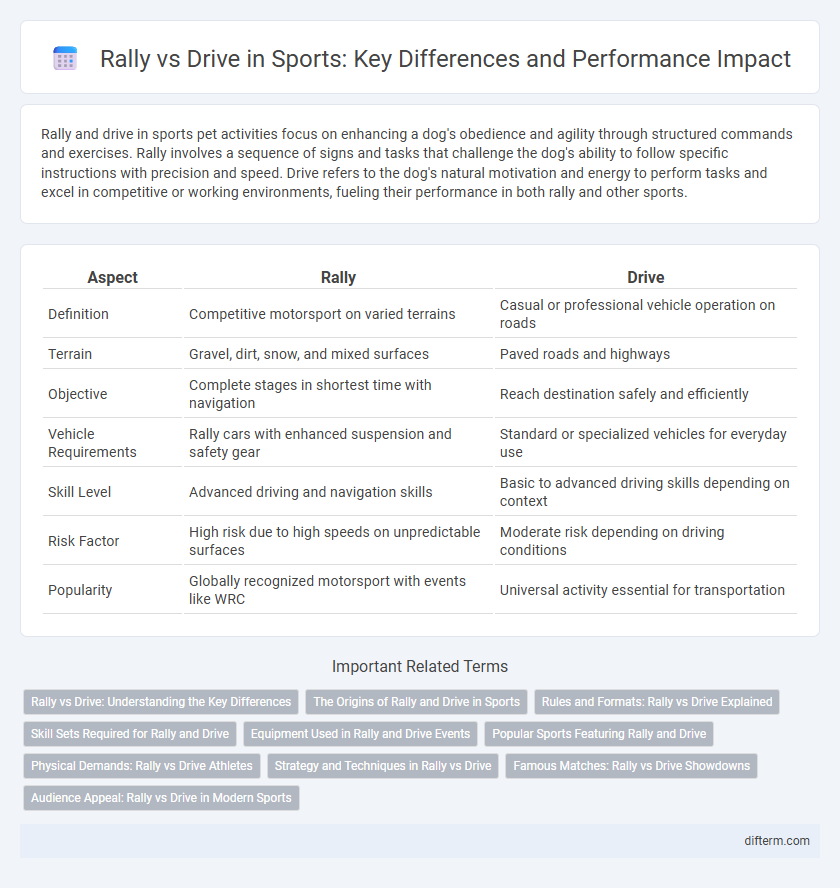Rally and drive in sports pet activities focus on enhancing a dog's obedience and agility through structured commands and exercises. Rally involves a sequence of signs and tasks that challenge the dog's ability to follow specific instructions with precision and speed. Drive refers to the dog's natural motivation and energy to perform tasks and excel in competitive or working environments, fueling their performance in both rally and other sports.
Table of Comparison
| Aspect | Rally | Drive |
|---|---|---|
| Definition | Competitive motorsport on varied terrains | Casual or professional vehicle operation on roads |
| Terrain | Gravel, dirt, snow, and mixed surfaces | Paved roads and highways |
| Objective | Complete stages in shortest time with navigation | Reach destination safely and efficiently |
| Vehicle Requirements | Rally cars with enhanced suspension and safety gear | Standard or specialized vehicles for everyday use |
| Skill Level | Advanced driving and navigation skills | Basic to advanced driving skills depending on context |
| Risk Factor | High risk due to high speeds on unpredictable surfaces | Moderate risk depending on driving conditions |
| Popularity | Globally recognized motorsport with events like WRC | Universal activity essential for transportation |
Rally vs Drive: Understanding the Key Differences
Rally focuses on high-speed navigation through off-road terrain using a co-driver for precise instructions, emphasizing endurance, control, and teamwork. Drive typically refers to regular or performance driving on paved roads, prioritizing speed, handling, and individual skill. Understanding these differences highlights rally's unique blend of strategy and rugged conditions compared to the technical precision required in standard driving.
The Origins of Rally and Drive in Sports
Rally racing originated in the early 20th century as long-distance endurance events testing both driver skill and vehicle durability on unpaved roads, evolving into a distinct motorsport with specialized vehicles and stages. Drive, in the context of motorsports, refers broadly to various forms of racing where speed and vehicle control are paramount, including circuit racing and time trials that emerged concurrently with the rise of the automobile industry. The historical roots of rally emphasize navigation and varied terrain, differentiating it from other drive-based competitions focused on speed and lap times.
Rules and Formats: Rally vs Drive Explained
Rally racing features timed stages on closed public or off-road courses where drivers and co-drivers follow precise pace notes to navigate varied terrain under strict rules governing safety and vehicle modifications. Drive events, such as drag racing or circuit racing, occur on controlled tracks focusing on speed and lap times with standardized vehicle classes and regulations for fair competition. Both formats enforce specific technical and safety requirements, but rally emphasizes endurance and navigation across unpredictable conditions, while drive prioritizes speed and consistency on a defined course.
Skill Sets Required for Rally and Drive
Rally driving demands advanced skills in car control, navigation, and quick decision-making on unpredictable terrains, emphasizing precise handling and adaptability. In contrast, traditional driving focuses on consistent road safety, adherence to traffic regulations, and smooth vehicle operation in controlled environments. Mastery in rally requires proficiency in reading pace notes and maintaining high concentration under extreme conditions, distinguishing it from regular driving skill sets.
Equipment Used in Rally and Drive Events
Rally events utilize specialized equipment such as reinforced roll cages, rally tires designed for mixed terrain, and advanced suspension systems to handle rough off-road conditions, ensuring optimal performance and safety. Drive events typically rely on standard or slightly modified vehicles equipped with performance tires and braking systems tailored for smooth, paved surfaces, emphasizing speed and precision. The stark contrast in equipment reflects the unique demands of rally stages versus controlled driving courses.
Popular Sports Featuring Rally and Drive
Rally and drive are key components in motorsport disciplines such as rally racing and drag racing, which showcase skillful vehicle handling and speed. Rally racing features timed stages across varied terrains, emphasizing endurance and precise navigation, while drag racing focuses on short, straight-line acceleration to achieve maximum speed in the shortest time. Both sports attract large audiences and require advanced driving techniques, making them popular in the global motorsport community.
Physical Demands: Rally vs Drive Athletes
Rally athletes face intense physical demands blending endurance, agility, and precise motor skills to navigate unpredictable terrains at high speeds. Drive athletes require explosive power, quick reaction times, and sustained muscular strength to control vehicles during high-intensity sprints or circuit races. Both sports demand exceptional cardiovascular fitness, but rallying emphasizes sustained focus over long durations, while driving prioritizes short bursts of maximal effort and rapid decision-making.
Strategy and Techniques in Rally vs Drive
Rally racing demands advanced techniques such as precise car control on varied terrains, effective navigation with co-drivers, and adaptive braking strategies to maintain speed and safety. Driving in everyday conditions prioritizes smooth acceleration, defensive driving, and adherence to traffic rules over aggressive maneuvers. The strategic approach in rally emphasizes quick decision-making and terrain-specific handling, whereas regular driving focuses on consistency and risk management.
Famous Matches: Rally vs Drive Showdowns
Famous rally vs drive showdowns in motorsport history capture the intense rivalry between precision-driven rally driving and the high-speed control of circuit racing. Iconic events such as the Dakar Rally and the Monte Carlo Rally showcase the endurance and adaptability of rally drivers, contrasting with the technical speed and strategic overtakes seen in Formula 1 and World Rally Championship drives. These legendary matches highlight the distinct skills and thrills that define rally and drive competitions, drawing passionate fans worldwide.
Audience Appeal: Rally vs Drive in Modern Sports
Rally events captivate audiences through dynamic teamwork, strategic pacing, and dramatic terrain challenges that create intense, unpredictable moments. Drive-based sports emphasize individual skill, precision, and speed, appealing to fans who value personal mastery and technical prowess. Both formats attract diverse viewership by blending excitement with unique competitive elements, enhancing overall spectator engagement.
rally vs drive Infographic

 difterm.com
difterm.com